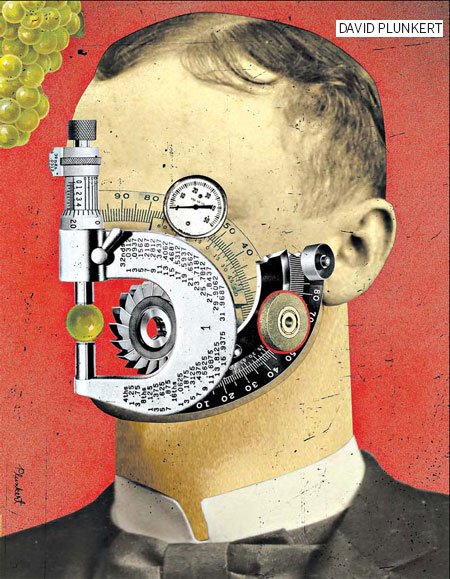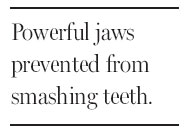The mouth's work as food processor
Updated: 2013-04-07 07:44
By Mary Roach(The New York Times)
|
|||||||


WAGENINGEN, the Netherlands - In Food Valley, a cluster of universities and research facilities, nearly 15,000 scientists are dedicated to improving - or, depending on your sentiments about processed food, compromising - the quality of our meals.
Here I am, in the Restaurant of the Future, a cafeteria at Wageningen University where hidden cameras record diners as they make decisions about what to eat. And here is a bowl of rubbery white cubes the size of salad croutons. Dr. Andries van der Bilt has brought them from his lab at the nearby University Medical Center Utrecht.
"You chew them," he said.
An oral physiologist, Dr. Van der Bilt uses the cubes to quantify "masticatory performance" - how effectively a person chews.
If you ever, as a child, chewed on a whimsical pencil eraser in the shape of, say, an animal or a piece of fruit, then you have tasted this dish.
"I'm sorry." Dr. Van der Bilt winces. "It's quite old." As though fresh silicone might be better.
He and his colleagues study the mouth's role as the human food processor.
Chewing is as unique and consistent as the way you walk. There are fast chewers and slow chewers, long chewers and short chewers, right-chewing people and left-chewing people. Some of us chew straight up and down, and others chew side-to-side, like cows.
Dr. Van der Bilt studies the neuromuscular elements of chewing. You often hear about the impressive power of the jaw muscles. In terms of pressure per single burst of activity, these are the strongest muscles we have. But it is the jaw's nuanced ability to protect that fascinates Dr. Van der Bilt.
Think of a peanut between two molars, about to be crushed. At the precise millisecond the nut succumbs, the jaw muscles sense the yielding and let up. Without that reflex, the molars would continue to hurtle recklessly toward one another, now with no intact nut between.
To keep your jaw muscles from smashing your teeth, the body evolved an automated braking system. The faster and more recklessly you close your mouth, the less force the muscles are willing to apply. Without your giving it a conscious thought.
The study of oral processing is about the entire "oral device" - teeth, tongue, lips, cheeks, saliva, all working together toward a singular revolting goal, bolus formation.
"Bolus," here, refers to a mass of chewed, saliva-moistened food particles - food that is in, as one researcher put it, "the swallowable state."
Bolus formation and swallowing depend on a highly coordinated sequence of neuromuscular events and reflexes, researchers have found. Disable any one of these - via stroke, degenerative neurological condition, tumor irradiation - and the seamless, moist ballet begins to fall apart. The umbrella term is dysphagia, from the Greek for "disordered eating."
The larynx (voice box) usually blocks the entrance to the esophagus. When food or drink is ready to be swallowed, the larynx has to rise out of the way, both to allow access to the esophagus and to close off the windpipe and prevent the food from "going down the wrong way."
To allow this to happen, the bolus is held momentarily at the back of the tongue, a sort of anatomical metering light. If, as a result of dysphagia, the larynx doesn't move quickly enough, the food can head down the windpipe instead. This is, obviously, a choking hazard. More sinisterly, inhaled food and drink can deliver a troublesome load of bacteria. Infection can set in and progress to pneumonia.
A more entertaining swallowing misstep is nasal regurgitation. Here the soft palate fails to seal the opening to the nasal cavity. This leaves milk or chewed peas in peril of being expelled through the nostrils. Nasal regurgitation is more common with children, because they often laugh while eating and because their swallowing mechanism isn't fully developed.
"Immature swallowing coordination" is the reason 90 percent of food-related choking deaths befall children under 5. Also contributing: immature dentition. Children grow incisors before they have molars; for a brief span of time they can bite off pieces of food but cannot chew them.
Round foods are particularly treacherous because they match the shape of the trachea. If a grape goes down the wrong way, it blocks the tube so completely that no breath can be drawn around it.
Those who can chew want to chew. We especially enjoy crunch. A colleague of Dr. Van der Bilt, Dr. Ton van Vliet, has spent seven years figuring out how crunch works.
Back at the Restaurant of the Future, he stops by to instruct me in the basics of crispy-crunchy. "It's all bubbles and beams," he said, sketching networks of water-filled cells and cell walls. When you bite into an apple, the flesh deforms and at a certain moment the cell walls burst. And there is your crunch. In crispy snack foods, the bubbles are filled with air.
As a piece of produce begins to decay, the cell walls break down and water leaks out. Now nothing bursts.
For a food to make an audible noise when it breaks, there must be what's called a brittle fracture: a sudden, high-speed crack. Dr. Van Vliet takes a puffed cassava chip from a bag and snaps it in two.
"To get this noise, you need crack speeds of 300 meters per second," he said. The speed of sound. The crunch of a chip is a tiny sonic boom inside your mouth.
"You eat physical properties with a little bit of taste and aroma," Dr. Van Vliet said. "And if the physics is not good, then you don't eat it."
The New York Times
(China Daily 04/07/2013 page11)